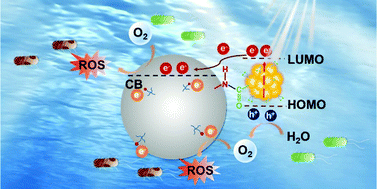Marrying luminescent Au nanoclusters to TiO2 for visible-light-driven antibacterial application†
Abstract
Long-lasting yet visible-light-driven bacterial inhibition is highly desired for environmental protection and public health maintenance. However, conventional semiconductors such as titanium dioxide (TiO2) are impotent for such antibacterial application due to their low utilization rate for visible light. Herein we report the design of a long-lasting yet visible-light-driven antibacterial agent based on marrying luminescent Au nanoclusters (Au NCs for short) to TiO2 (TiO2-NH2@Au NCs). The as-obtained TiO2-NH2@Au NC antibacterial agent not only possesses superior utilization for visible light due to the participation of Au NCs as a good photosensitizer, but also has excellent separation efficacy of photogenerated carriers, thereby efficiently enhancing the generation of reactive oxygen species (ROS) for killing bacteria. Consequently, the TiO2-NH2@Au NCs display excellent antibacterial activity with good durability against both Gram-positive and Gram-negative bacteria such as Staphylococcus aureus (99.37%) and Escherichia coli (99.92%) under visible-light irradiation (λ ≥ 400 nm). This study is interesting because it provides a paradigm change in the design of long-lasting yet visible-light-driven NC-based antibacterial agents for diversified bactericidal applications.

- This article is part of the themed collections: Nanoscale 2022 Emerging Investigators, Nanoscale 2022 Lunar New Year Collection, Nanoscale Most Popular 2021 Articles and 2021 Nanoscale HOT Article Collection


 Please wait while we load your content...
Please wait while we load your content...